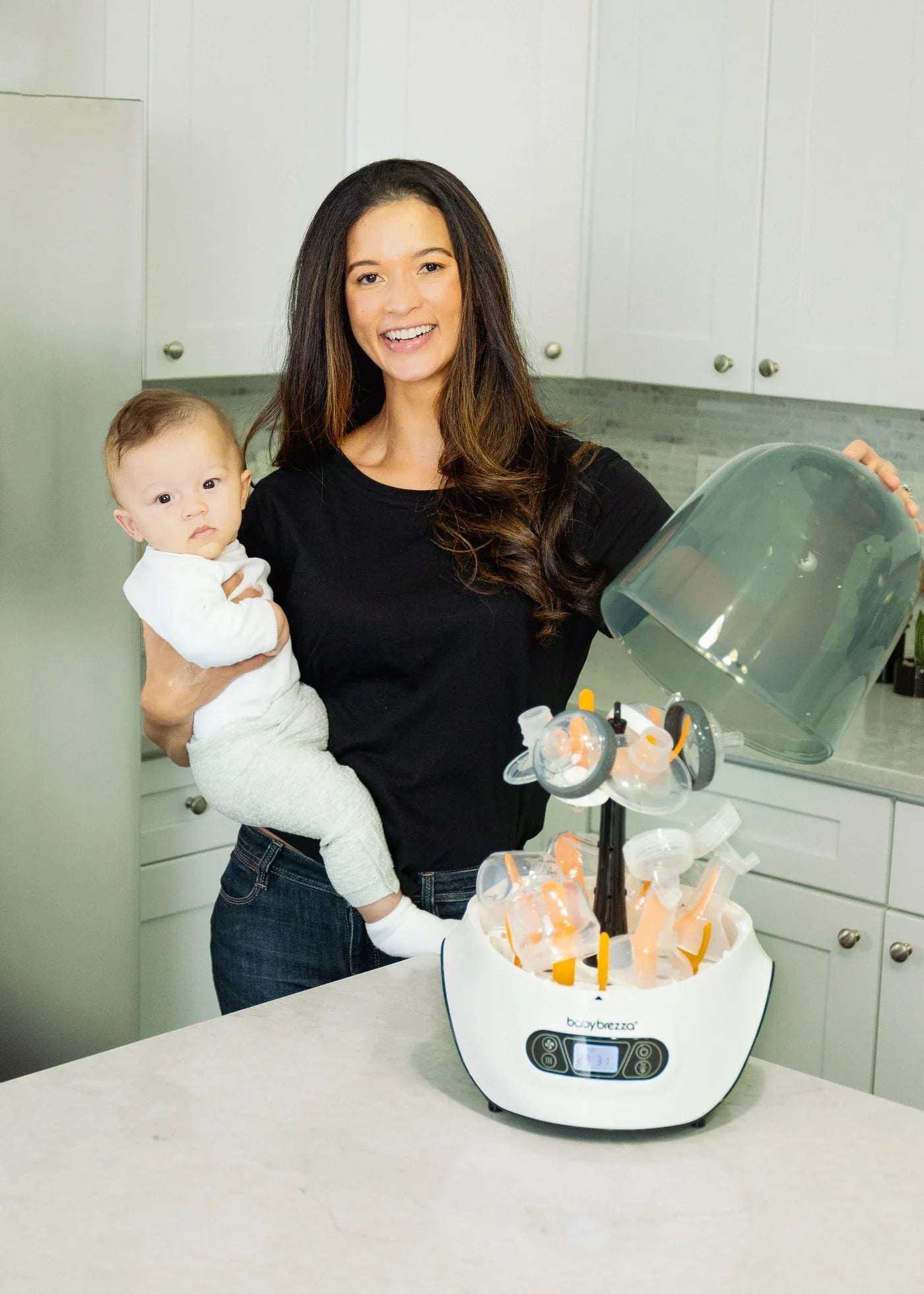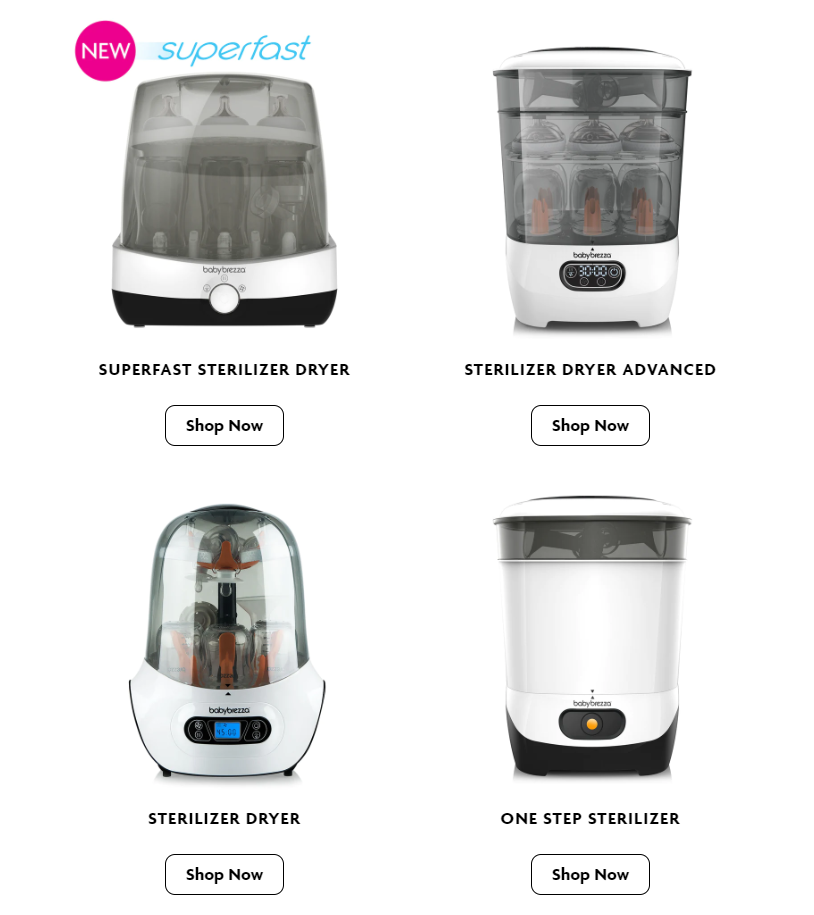You’ve probably read that you should sterilize baby bottles and pump parts before first use and regularly thereafter. So now you’re wondering, how should I sterilize everything, and how often? Is sterilizing baby bottles necessary? What’s the best way to dry each piece? We’ll answer all of that and more below, so that learning how to sterilize baby bottles never becomes a guessing game again.
How often should I sterilize baby bottles?
Baby products like bottles, teething toys, pacifiers, and more should be sterilized on a daily or per-use basis. This is because your baby’s immune system is weaker, especially depending on how young they are; the closer to newborn they are, the more sensitive they are to bacteria and sickness. Daily sanitizing of these items may not be necessary for older, healthy babies if those items are cleaned carefully after each use. In learning how to sanitize baby bottles and parts, though, it’s always better to be safe than sorry.
Is sterilizing baby bottles and products even necessary?
Sanitizing and sterilizing baby bottles is particularly important when your baby is younger than 2 months, was born prematurely, or has a weakened immune system. Improperly cleaned baby bottles have the potential to attract germs that might lead newborns to be ill.
Due to these necessary steps to keep your newborn baby healthy, there are multiple ways to sterilize baby bottles. Though some methods may be easier or more affordable, not all of these methods are effective or fast.
Let’s start off with some of the pros and cons of the different approaches to sterilizing bottles and pump parts. And then answer the million dollar question – what is the best way to sterilize and dry, ultimately?
Sterilizing by Boiling Baby Bottles
Many parents sterilize baby bottles by sanitizing them in boiling water. Why boil baby bottles? The reason – you don’t need anything special. Just grab a large pot, put the baby products in it, cover them all with water, and then boil them.
Pros and Cons of Boiling Baby Bottles
Pros:
- Accessibility: No special equipment required; just a large pot and water. This makes it a convenient option for any household without needing to purchase additional items, especially in emergencies.
- Effectiveness: Reaches temperatures that can kill most bacteria and germs. The boiling process ensures that harmful microorganisms are eliminated, providing a safer feeding experience for your baby.
- Thoroughness: Ensures all parts of the bottles are exposed to high heat. The boiling water circulates around the bottles, ensuring that even hard-to-reach areas are sanitized, leaving no room for bacteria to hide.
Cons:
- Time-Consuming: Boiling water can take a long time. This method requires waiting for the water to reach a boil and then additional time for the actual sterilization process, which can be inconvenient for busy parents.
- Monitoring Required: Bottles can float, requiring constant supervision to keep them submerged. This means you need to stay by the stove to ensure the bottles remain fully covered by water, which can be an added hassle.
- Safety Risks: Handling boiling water poses a risk of burns. Extracting the bottles from the hot water can be hazardous, especially with the potential for splashing or accidental spills, necessitating extreme caution.
- Drying Challenges: Must use a sterile drying rack to avoid recontamination. If non-sterile items are used for drying, the sterilization process is compromised, rendering it ineffective and negating the effort.
Sterilizing with Hot Water
Parents sterilize baby bottles using hot water, too. It has many of the same pros and cons as boiling[2].
Pros and Cons of Using Hot Water
Pros:
- Accessibility: No special equipment required; just your sink and hot water. This makes it a very convenient option, especially when you need to quickly rinse bottles in a pinch.
- Simplicity: Easy to implement; just run the baby bottles under hot water. This straightforward method requires minimal setup and is easy for anyone to do.
- Gentle on Bottles: Hot water is less likely to cause wear and tear on baby bottles compared to other methods. This can help prolong the life of your bottles, saving you money over time.
Cons:
- Time-Consuming: Running bottles under hot water can take a considerable amount of time. This method requires you to hold each bottle under the hot water for an extended period, which can be inefficient and waste water.
- Ineffectiveness: Hot water doesn’t reach 212 degrees F, the temperature required to kill 99.9% of germs. This means that this method is less effective at thoroughly sterilizing the bottles.
- Monitoring Required: Continuous supervision is needed to ensure all parts of the bottles are exposed to hot water. This can be inconvenient and labor-intensive, especially with multiple bottles.
- Drying Challenges: Must use a sterile drying rack to avoid recontamination. If non-sterile items are used for drying, the sterilization process is compromised, making the entire effort ineffective.
Sterilizing with Microwave Steam Bag
Some parents also use a microwave steam bag to sterilize baby bottles. This solution is one parents turn to because of its simplicity. The process consists of putting the baby products in the steam bag, putting it in your microwave, and letting it run[3].
Pros:
- Simplicity: Easy to use; just place bottles in the bag and microwave. This method streamlines the process, making it quick and hassle-free, ideal for parents seeking convenience.
- Quick Process: Sterilizes bottles in a short amount of time. In just a few minutes, you can have sterilized bottles ready for use, making it ideal for busy parents with tight schedules.
- Portability: Steam bags are compact and easy to transport. This makes them perfect for traveling or when you need to sterilize bottles away from home, offering flexibility and convenience.
Cons:
- Safety Concerns: Risk of burns from hot steam when opening the bag. Care must be taken to avoid the rush of steam that can cause serious burns, requiring careful handling.
- Limited Capacity: Can only sterilize a few bottles at a time. This limitation means you may need to run multiple cycles to sterilize all necessary items, which can be time-consuming.
- Durability: Steam bags may wear out or become damaged over time. Regular use can lead to wear and tear, requiring replacements to maintain effectiveness, adding to the cost over time.
- Dependence on a Microwave: Requires access to a microwave, limiting where it can be used. This dependency can be inconvenient in places where a microwave is not available, restricting its usability.
Sterilizing Baby Bottles in the Dishwasher
Many modern dishwashers come equipped with a sanitize cycle that reaches high enough temperatures to kill bacteria and germs, making them a convenient option for sterilizing baby bottles. Why use a dishwasher? It’s hands-off, multi-tasking, and utilizes an appliance you likely already own. Simply load the bottles (disassembled), nipples, and any accessories on the top rack, select the sanitize or high-heat drying cycle, and let the dishwasher do the rest.
Pros and Cons of Using the Dishwasher to Sterilize Baby Bottles
Pros:
- Convenient and Hands-Free: Just load and press start. The dishwasher saves time and effort by handling multiple bottles and accessories at once, freeing up your hands for other tasks.
- Multi-Functional: Cleans and sterilizes at the same time. There's no need for a separate cleaning step; everything gets washed and sanitized in one go, streamlining your routine.
-
Safe and Contained: No open flames or hot pots to manage. With the dishwasher, there's less risk of accidental burns or splashes, making it a safer choice, especially in a busy kitchen.
Cons:
- Not Universally Effective: Only works if your dishwasher has a sanitize or high-heat cycle. Without this feature, your dishwasher may not reach temperatures high enough to properly sterilize baby items.
- Potential for Warping: Some bottle parts may not be dishwasher-safe. High temperatures and vigorous washing can warp or degrade plastic parts, so it’s essential to check the manufacturer’s guidelines.
- May Miss Tight Spaces: Bottles and accessories need to be placed carefully. If not positioned properly, water and steam may not reach inside narrow or hidden areas, leaving them less than fully sterile.
- Long Cycle Times: Sanitize cycles can take hours. This method isn't ideal if you need bottles quickly, as the full cycle, including drying, may be quite time-consuming.
The Best Way to Sterilize Baby Bottles
For parents seeking a simple, reliable, and highly effective way to sterilize baby bottles, a bottle sterilizer offers the most streamlined solution. Brands like Baby Brezza take convenience to the next level by combining sterilizing, drying, and storage into one easy-to-use appliance. Whether you choose a steam-based model or a more advanced sterilizer-dryer combo, it’s designed specifically with baby feeding hygiene in mind.
Pros and Cons of Using a Bottle Sterilizer
Pros:
- Designed for the Job: Purpose-built to sanitize baby bottles and accessories. Unlike boiling or dishwashing, sterilizers like the Baby Brezza One Step™ Sterilizer-Dryer are tailored to baby care, ensuring every item is evenly exposed to high-temperature steam for maximum germ-killing power.
- All-in-One Convenience: Sterilize, dry, and store in a single appliance. With Baby Brezza, there’s no need to transfer wet bottles to a separate drying rack; just press a button and come back to clean, dry, ready-to-use bottles.
- Time-Saving: Quick cycles and automatic drying. Models like the Superfast Baby Bottle Sterilizer and Dryer sterilize and dry in 10 minutes.
- Hygienic Storage: Keeps bottles sterile for up to 48 hours. The sealed design ensures bottles remain sterile if the lid is unopened, giving you peace of mind for the next feed.
Cons:
- Initial Cost: More expensive than boiling or dishwashing. Investing in a Baby Brezza sterilizer means an upfront purchase, though many parents find the time savings and peace of mind well worth the cost.
- Counter Space Needed: Requires dedicated space in your kitchen. Like any appliance, it takes up room on the counter, which may be a consideration in smaller kitchens. However, the Baby Brezza Sterilizer Dryer Mini is 65% smaller than other sterilizers, making it great for smaller kitchens.
- Requires Regular Maintenance: Needs routine descaling and cleaning. To ensure continued effectiveness, the heating plate and interior should be cleaned regularly, though this is a small task compared to the time saved daily.
The best way to sterilize is also the best way to dry. Use a sterilizer-dryer like the Baby Brezza One Step Sterilizer-Dryer. It automatically sterilizes and dries bottles, pump parts, and other accessories.

The Baby Brezza One Step Sterilizer-Dryer is super easy to use – just load up your baby products into the appliance, push one button, and it will sterilize using natural steam. Afterwards, it will dry all the products, all within an hour. This one step sterilizer-dryer keeps everything sterile for up to 24 hours inside. That way, when you’re ready to feed your baby or pump again, your baby products are ready to go.
Do you need to wash bottles before sterilizing?
While sterilizers like our SUPERFAST Sterilizer Dryer kill germs and dry bottles, they do not clean them. You will still need to wash baby bottles, pump parts and accessories prior to using our sterilizers. However, our revolutionary Bottle Washer Pro does it all; using powerful jets and baby safe detergent, it’ll thoroughly clean bottles and equipment. It also sterilizes with steam and dries bottles completely. Additionally, bottles will remain germ free while stored in the bottle washer.
Can you sterilize all bottle types?
Of course! Our Sterilizers fit anywhere from 6 to 8 bottles depending on the model, and up to 2 pump part sets.
So what are you waiting for? Shop now and save 22% if you join Baby Brezza Rewards.


